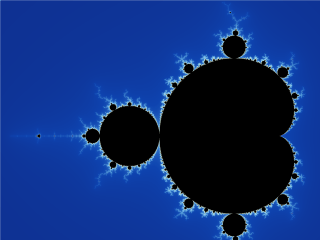

The Mandelbrot set is, for many, the quintessential fractal. When one zooms in on some part of the edge, one notices that the Mandelbrot set is, indeed, self-similar. Furthermore, if one zooms in even further on various sections of the edge, one obtains different Julia sets. In fact, it is "asymptotically similar to Julia sets near any point on its boundary," as proved in a theorem by the Chinese mathematician Tan Lei. [7]
Mandelbrot has managed not only to invent the discipline of fractal geometry, but has also popularized it through its applications to other areas of science. He clearly believed this was important, as he once stated [3]
The rare scholars who are nomads-by-choice are essential to the intellectual welfare of the settled disciplines.
As he hinted in How Long Is the Coast of Britain? fractal geometry comes in useful in representing natural phenomena; things such as coastlines, the silhouette of a tree, or the shape of snowflakes -- things are not easily represented using traditional Euclidean geometry. After all, no organic entity comes to mind when one contemplates a square or a circle. Equally, no simple shape from Euclidean geometry comes to mind when contemplating things such as the path of a river. Even the earth is not a perfect sphere, however convenient it may be for one's calculations to treat it as such. Furthermore, fractal geometry and chaos theory have important connections to physics, medicine, and the study of population dynamics. [7] However, even if the field lacked these links, it would be hard for those so inclined to resist the aesthetic appeal of most fractals.
Mandelbrot's non-traditional approach led him to invent an amazing and useful new form of mathematics. However, no mathematician can claim to have developed his results in complete isolation from anyone else's. Mandelbrot's discovery owes a great deal to the mathematicians who preceded him, such as Weierstrass and von Koch, but especially to Julia, Fatou, andHausdorff. He also benefitted from access to computers, which allowed him not only to build upon the works of others in a new way -- one which had definitely not been done before -- but to use his preferred method of solving problems -- namely visualisation. Furthermore, his invention also makes a case for the importance of the study of pure mathematics: until Mandelbrot came along and united the eclectic ideas of Hausdorff,Julia, et al, they represented very abstract mathematical ideas from varying branches of (pure) mathematics. There is very little that would interest an ordinary biologist about set theory. However, through fractal geometry, many of these seemingly abstract ideas (from mathematicians who are relatively unknown outside of their own spheres of research) develop applications that other scientists and even non-scientists can appreciate. Thus, the work that eventually led to fractals and their applications are an excellent counterexample to the arguments of anyone who would dare to denigrate the study of pure mathematics.
For more information - Search:
MacTutor History of Mathematics Archive
WHERE DOES MATH COME FROM?
Links to Mathematics Publishers and Aggregator sites.
History of Mathematics Websites
These are websites that relate specifically to the historical development of mathematics. Some may not look so pretty but they are populated with important and relevant information.

LC Call No. & Subject Collection
| CALL NUMBERS | SUBJECT GUIDE |
| QA 8-QA 9 | Mathematical Logic and Foundations |
| QA 13-QA 29 | History of Mathematics |
| QA 76.76 | Computer Science |
| QA 184-QA 188 | Linear and Multilinear Algebras and Matrix Theory |
| QA 241-QA 246 | Number Theory |
| QA 269-QA 272 | Game Theory, Economics, Social and Behavioral Sciences |
| QA 273-QA 274 | Probability Theory and Stochastic Processes |
| QA 276 | Statistics Computing and Software |
| QA 299-QA 320 | Real Functions Analysis |
| QA 371-QA 377 | Partial Differential Equations |
| QA 402.5 | Optimization |
| QA 611 | Topology |
| QA 641-QA 649 | Differential Geometry |